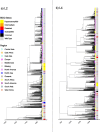Detection of a historic reservoir of bedaquiline/clofazimine resistance-associated variants in Mycobacterium tuberculosis
- PMID: 38374151
- PMCID: PMC10877763
- DOI: 10.1186/s13073-024-01289-5
Detection of a historic reservoir of bedaquiline/clofazimine resistance-associated variants in Mycobacterium tuberculosis
Abstract
Background: Drug resistance in tuberculosis (TB) poses a major ongoing challenge to public health. The recent inclusion of bedaquiline into TB drug regimens has improved treatment outcomes, but this advance is threatened by the emergence of strains of Mycobacterium tuberculosis (Mtb) resistant to bedaquiline. Clinical bedaquiline resistance is most frequently conferred by off-target resistance-associated variants (RAVs) in the mmpR5 gene (Rv0678), the regulator of an efflux pump, which can also confer cross-resistance to clofazimine, another TB drug.
Methods: We compiled a dataset of 3682 Mtb genomes, including 180 carrying variants in mmpR5, and its immediate background (i.e. mmpR5 promoter and adjacent mmpL5 gene), that have been associated to borderline (henceforth intermediate) or confirmed resistance to bedaquiline. We characterised the occurrence of all nonsynonymous mutations in mmpR5 in this dataset and estimated, using time-resolved phylogenetic methods, the age of their emergence.
Results: We identified eight cases where RAVs were present in the genomes of strains collected prior to the use of bedaquiline in TB treatment regimes. Phylogenetic reconstruction points to multiple emergence events and circulation of RAVs in mmpR5, some estimated to predate the introduction of bedaquiline. However, epistatic interactions can complicate bedaquiline drug-susceptibility prediction from genetic sequence data. Indeed, in one clade, Ile67fs (a RAV when considered in isolation) was estimated to have emerged prior to the antibiotic era, together with a resistance reverting mmpL5 mutation.
Conclusions: The presence of a pre-existing reservoir of Mtb strains carrying bedaquiline RAVs prior to its clinical use augments the need for rapid drug susceptibility testing and individualised regimen selection to safeguard the use of bedaquiline in TB care and control.
Keywords: AMR; Bedaquiline; Drug resistance; Phylogenetics; Tuberculosis.
© 2024. The Author(s).
Conflict of interest statement
AP is currently employed by Janssen. Dr Pym’s involvement with the research described herein precedes his employment at Janssen. The remaining authors declare that they have no competing interests.
Figures



Comment in
-
The exceptions that prove the rule-a historical view of bedaquiline susceptibility.Genome Med. 2024 Mar 13;16(1):39. doi: 10.1186/s13073-024-01311-w. Genome Med. 2024. PMID: 38481348 Free PMC article.
References
-
- World Health Organization. Global tuberculosis report 2022. (WHO, 2022).
-
- World Health Organization. Global tuberculosis report 2019. (2019).
Publication types
MeSH terms
Substances
Grants and funding
LinkOut - more resources
Full Text Sources
Medical

